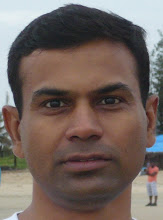About Bahrain
This is information about a country where I spent 8.5 successful years -
GEOGRAPHY
Bahrain is an archipelago of 33 islands, with a total land area in excess of 700 sq.kms. Its name is derived from two Arabic words "thnain Bahr" meaning "two seas" and refers to the phenomenon of sweet water springs under the sea which mingle with the salty water. This phenomenon is believed to be responsible for the unusual luster of Bahrain's natural pearls, the country's major economy before the advent of oil. In addition, the land was once blessed with a remarkable number of natural springs, which irrigated the fertile north and western belts for centuries. The central area is low lying and barren limestone rock covered with saline sand, which supports only hardiest desert vegetation. The highest point of Bahrain is the Jabel Dukhan, 134 meters above the sea level. The majority of Bahrain's oil wells are in this area. King Fahad Causeway connects Bahrain to Saudi Arabia - only 25km away.
HISTORY
Bahrain was once connected to the Arabian mainland, only becoming an island about 600 BC, and it is believed that prehistoric settlers could have first occupied the islands as early as 10,000 BC. Trading accounts of the Sumerians from 3,000 BC record a land called Dilmun, the first mention of Bahrain's oldest recorded civilization. The climate of the Gulf was much more temperate in the days of the Dilmun civilization than nowadays, although the Gulf region was already turning to desert. Dilmun, or Tilmun, was one of the great trading empires and a major centre on the trade route between Mesopotamia and the Indian subcontinent.
DEMOGRAPHIC INFORMATION
Most of the population of Bahrain is concentrated in the two principals cities, Manama and Al Muharraq. Islam is the official religion. Hindus, Roman Catholic and Protestant churches, as well as a tiny indigenous Jewish community, also exist in Bahrain. Although Arabic is the official language, English is widely spoken.The country offers a fascinating blend of eastern and western cultures as high rise buildings vie for space with more traditional dwellings and ancient traditions and historical sites mix with modern developments and cosmopolitan living. Bahrain's population of around 650,000 consists of a significant percentage of expatriates from all over the world. Locals and expatriates live together and interact in a rare bond of fraternity and brotherhood. Such charms, along with an excellent network of hotels, apartments and restaurants, attract an increasing number of regional and international tourists.
GEOGRAPHY
Bahrain is an archipelago of 33 islands, with a total land area in excess of 700 sq.kms. Its name is derived from two Arabic words "thnain Bahr" meaning "two seas" and refers to the phenomenon of sweet water springs under the sea which mingle with the salty water. This phenomenon is believed to be responsible for the unusual luster of Bahrain's natural pearls, the country's major economy before the advent of oil. In addition, the land was once blessed with a remarkable number of natural springs, which irrigated the fertile north and western belts for centuries. The central area is low lying and barren limestone rock covered with saline sand, which supports only hardiest desert vegetation. The highest point of Bahrain is the Jabel Dukhan, 134 meters above the sea level. The majority of Bahrain's oil wells are in this area. King Fahad Causeway connects Bahrain to Saudi Arabia - only 25km away.
HISTORY
Bahrain was once connected to the Arabian mainland, only becoming an island about 600 BC, and it is believed that prehistoric settlers could have first occupied the islands as early as 10,000 BC. Trading accounts of the Sumerians from 3,000 BC record a land called Dilmun, the first mention of Bahrain's oldest recorded civilization. The climate of the Gulf was much more temperate in the days of the Dilmun civilization than nowadays, although the Gulf region was already turning to desert. Dilmun, or Tilmun, was one of the great trading empires and a major centre on the trade route between Mesopotamia and the Indian subcontinent.
DEMOGRAPHIC INFORMATION
Most of the population of Bahrain is concentrated in the two principals cities, Manama and Al Muharraq. Islam is the official religion. Hindus, Roman Catholic and Protestant churches, as well as a tiny indigenous Jewish community, also exist in Bahrain. Although Arabic is the official language, English is widely spoken.The country offers a fascinating blend of eastern and western cultures as high rise buildings vie for space with more traditional dwellings and ancient traditions and historical sites mix with modern developments and cosmopolitan living. Bahrain's population of around 650,000 consists of a significant percentage of expatriates from all over the world. Locals and expatriates live together and interact in a rare bond of fraternity and brotherhood. Such charms, along with an excellent network of hotels, apartments and restaurants, attract an increasing number of regional and international tourists.


0 Comments:
Post a Comment
<< Home